Solkadhi recipe (also known as solkadi, sol kadhi, kokum kadhi or kokum curry) is an essential drink for cooling the body during blistering Goan summers. This mauve-hued, tart digestive beverage is easy to make, and takes just 10 minutes of active time to prepare.

Table of Contents
About Solkadhi
Next time you are in Goa, go to any proper, local indigenous restaurants that serve Goan food. Have any thali there – veg, fish or non-veg thali – and on the plate you will see a dark pink colored drink in a small glass or a small bowl (vati). That, my friends, is the kokum curry.
Also known as solkadi, this beverage is an important part of Goan, Konkan and Malvani cuisine. It has both cooling and digestive properties, making it a perfect counter to the heavily spiced dishes of the Western Coastal Indian cuisines. Kokum curry has a sour taste similar to buttermilk or a Chaas, but with more savory undertones.
As with most Indian recipes, there are almost as many ways to make solkadi. It can be made with or without coconut milk, but today I am posting my mom’s recipe of kokum kadhi made with coconut milk.
My mom’s recipe is a unique one and is much loved in my family and I couldn’t resist sharing it with you. Coconut milk does reduce some of the tart flavor of kokum, but not too much.
My Mom’s solkadhi recipe is a nice blend of mildly sweet coconut milk, sour kokum and tempered Indian spices. I should note that we always temper the curry with a few spices and herbs, but this step can be skipped and is not essential.
At home I serve solkadi with rice and a curried bean dish like Usal, or a vegetable curry like the Goan Curry. I simply love it this way! You can also drink it after your lunch meal if you prefer, as it aids in the digestion of food and keeps your body cool.
What is Kokum
For all those who have never had kokum in their lives, please try this marvelous Indian fruit; it is amazing!
Kokum – also known as Garcinia indica – is a fruit bearing plant from the mangosteen family. The plant yields dark red colored fruit that are both sweet and sour. As kids, we would have the kokum fruits (photo below) with salt as a midday snack.
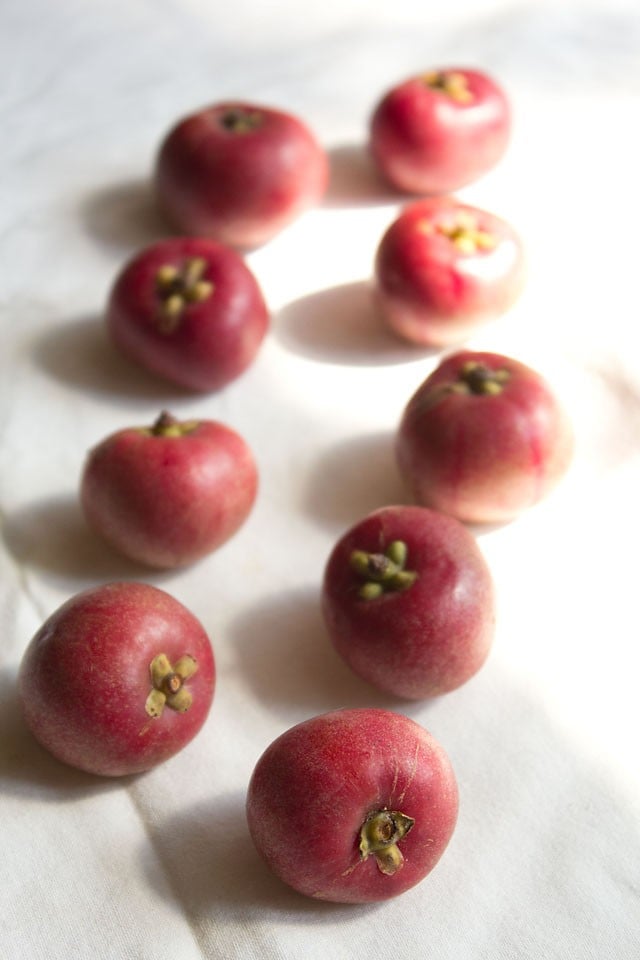
To get the ingredient we know as kokum or aamsol, the outer flesh of the fruit is dried in the sun. After drying, they turn blackish purple in color. These dried fruits are sour to taste and have a sweetish aroma.

The anthocyanins in the fruit add a dark purple hue to any dish that you add it to, including the purple-pink hue of this kokum curry.
Kokum is used in Goan and Malvan fish or prawn curries as a souring agent. It is also used in the Maharashtrian, Gujarati and Kerala cuisine. One of my favorite recipes using this Indian fruit is known as Kokum Juice.
This amazing fruit is used to rid the body of heat, and also serves to reduce the pitta dosha as per Ayurdeda. Kokum is also good for digestion, as well as helps in reducing itchiness from heat rash.
Actually it is very easy to get kokum if you stay in the southern parts and western coast of India. But if you stay in the north, then you can buy them online.
When living in Delhi, I had a tough time finding kokum anywhere (in the days when online stores and buying was not even heard of), especially when the Delhi heat used to be at its peak.

It really surprises me why they are not sold in the northern and central regions of India where the heat is such a killer. The kokum fruit is so good as a summer cooler. May be its got to do with the taste habits of people. There are many things from the North of India that I don’t get to buy in Goa and vice versa.
How to make Solkadhi
Making solkadhi recipe at home is really quite simple. Aside from the requisite soaking time, the whole recipe takes just 10 minutes to assemble when using canned or packaged coconut milk.
If you plan to make homemade coconut milk, then add in some more 10 to 15 minutes to your prep time.
Soak and Crush Kokum
1. Rinse 12 kokums under cool water. Place them in a bowl and add 1 cup water.

2. Soak the kokums in the water for 30 minutes.
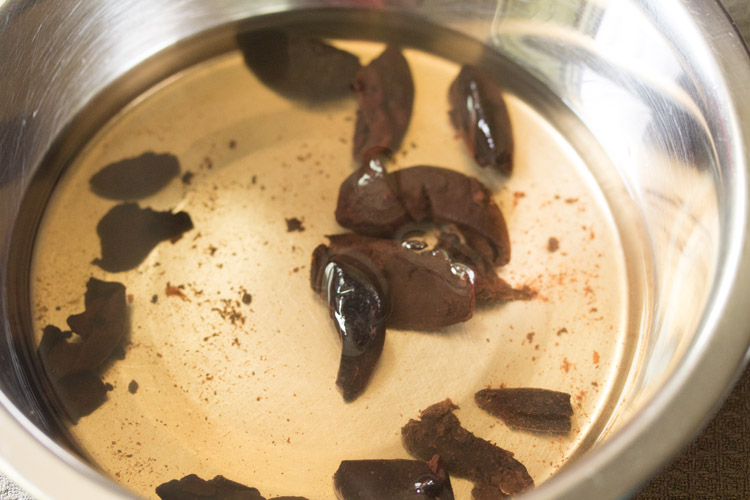
3. After 30 minutes, completely crush and squeeze kokum in the water by using your fingers.
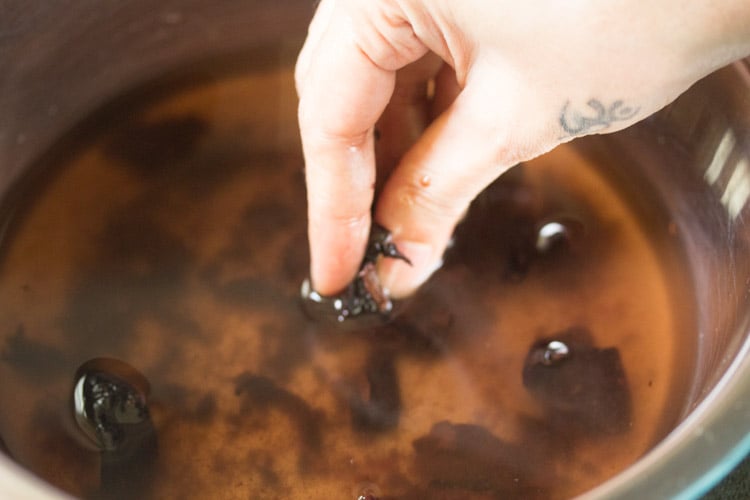
4. Pour the kokum extract in a strainer placed atop a bowl.
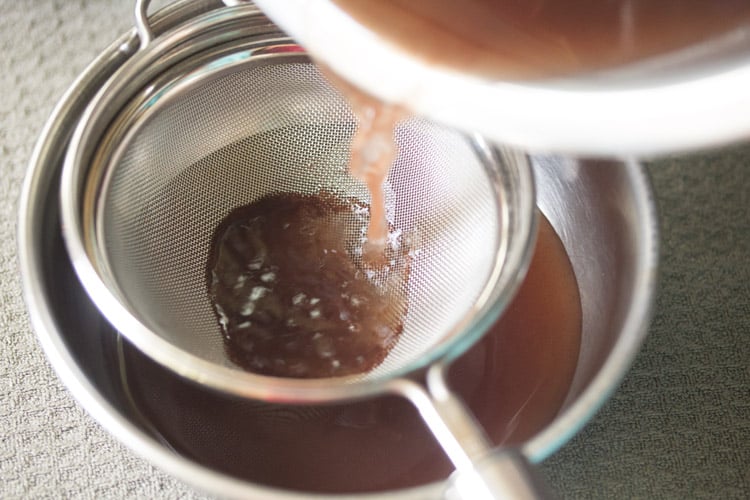
5. The kokum shreds will collect in the strainer.

6. Press the kokum shreds with a spoon to extract as much flavor as possible.

Make Solkadhi
7. Then add 2 cups water to the kokum extract.
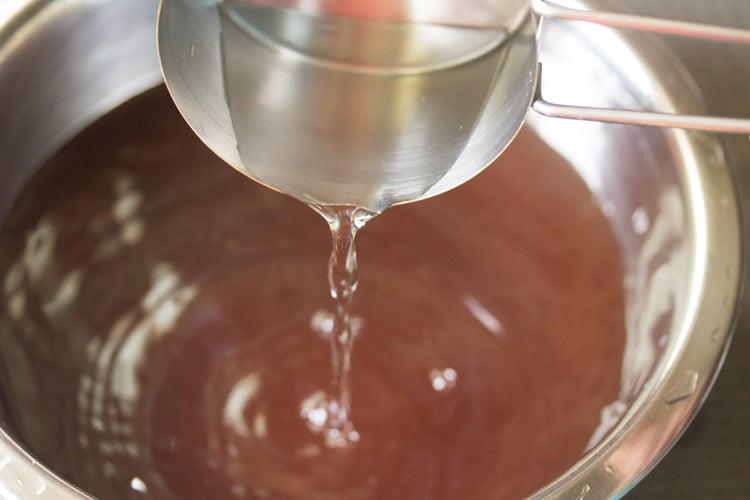
8. Next add 1 to 1.5 cups thick coconut milk. You can either make the coconut milk or use canned coconut milk.
NOTE: Always use thick coconut milk and not lite or thin coconut milk when making sol kadi. The lite coconut milk can curdle and separate after mixing with the kokum extract.
If you plan to make your own homemade coconut milk, then use the first extract only. Do not use coconut milk made from coconut powder as this can also curdle it as soon as you add it to the kokum extract.
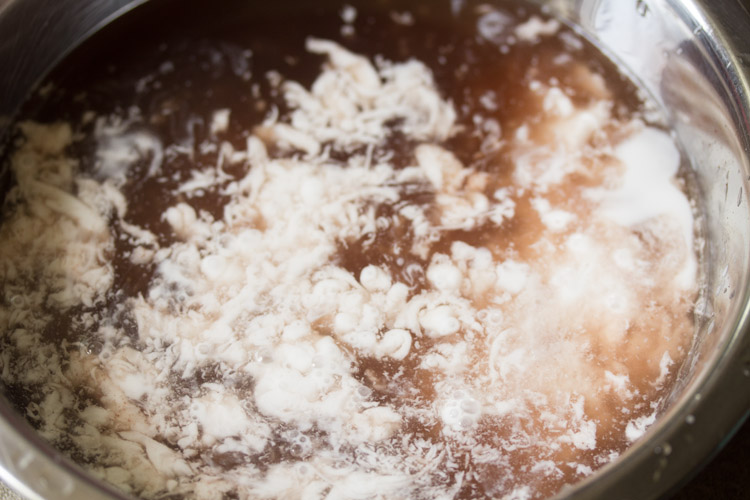
9. Mix very well.

10. Add salt to taste and mix again. Keep the kokum kadhi aside so that we prepare the tempering.

Make Tempering
11. Heat 1.5 tablespoons oil in a tadka pan or a small frying pan. Keep the heat to a low. Use any neutral tasting oil.
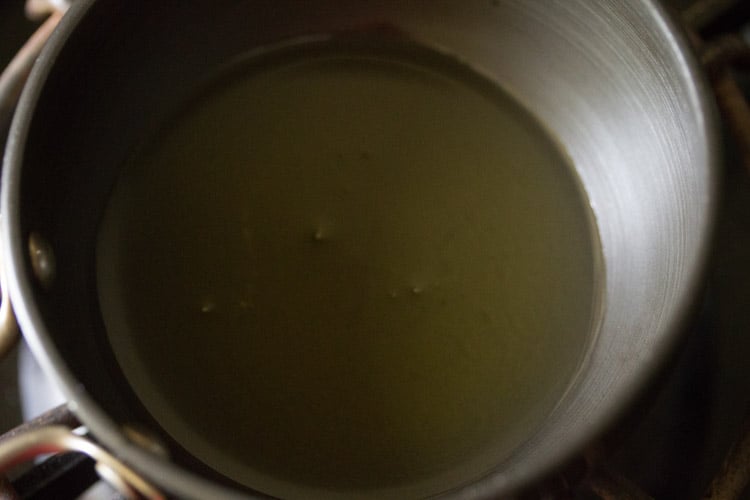
12. Add 1 teaspoon mustard seeds.

13. Let them crackle.
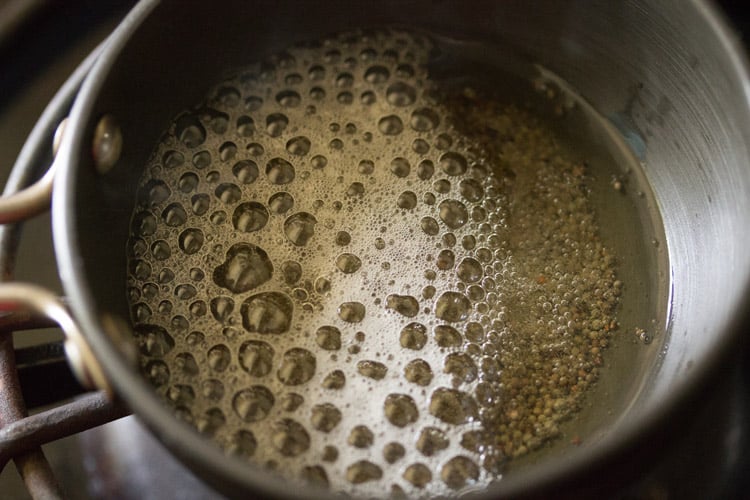
14. Then add 1 teaspoon cumin seeds and let them crackle too.
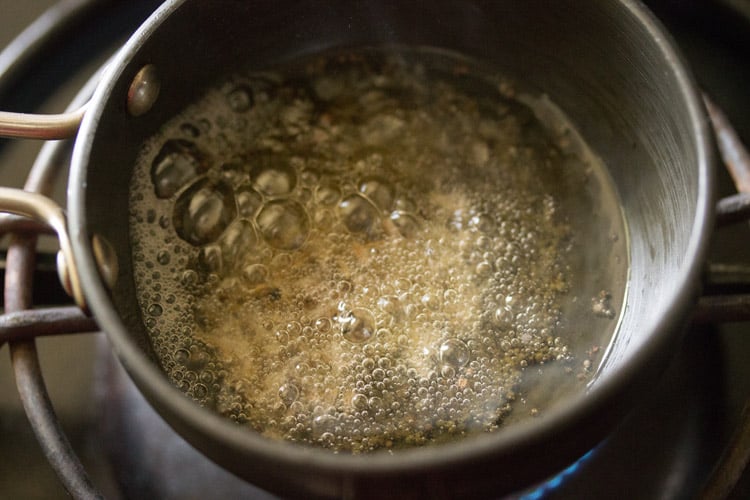
15. Lastly add the below listed spices and herbs:
- 1 sprig curry leaves or 9 to 10 curry leaves
- 1 to 2 dry red chilies (broken and seeds removed)
- 2 to 3 lightly crushed small to medium-sized crushed garlic cloves (with or without peels) – You can crush the garlic cloves in a mortar-pestle.
- 1 generous pinch of asafoetida powder (hing)
Stirring gently and often, fry for 30 seconds or so, till the garlic turns light golden.
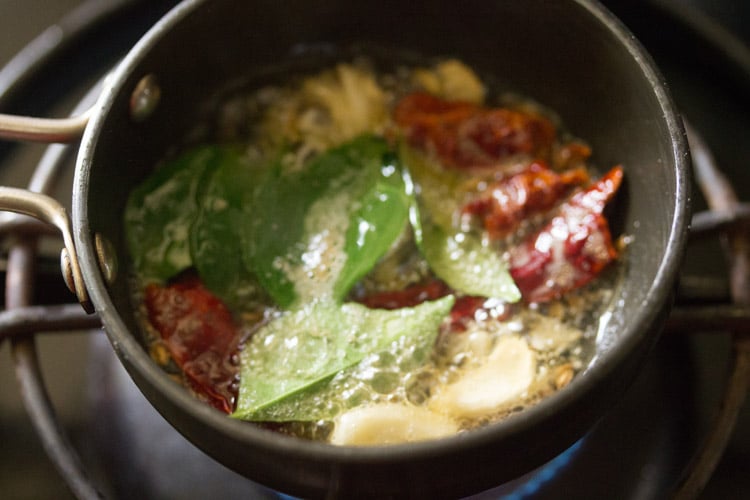
Assemble Solkadi
16. Quickly pour the tempering on the kokum and coconut milk mixture.

17. Mix well.

18. Add 1 to 2 tablespoons of finely chopped coriander leaves to the solkadi and mix again.
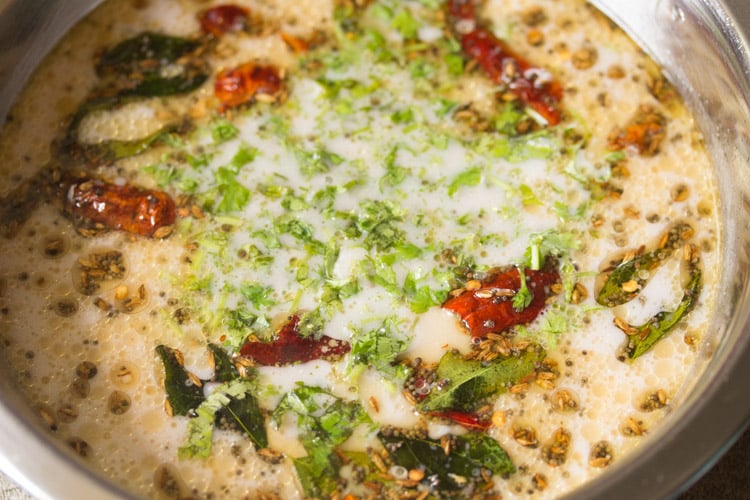
19. Serve solkadhi straight away, or refrigerate and then serve cold. You can garnish solkadi with coriander leaves before serving.

Tips & Tricks
This solkadhi recipe is very easy, and should only take about 10 minutes of active time. That said, I’ve learned some important lessons along the way:
- To make kokum kadhi more quickly, use ready-made canned coconut milk. If you make your own coconut milk, add an extra 10 to 15 minutes to the recipe time.
- Get all the flavor out! Straining and squeezing the kokum completely should not be rushed. Be sure to press on the soaked kokum shreds in the strainer to get all the beautifully sour pinkish red colored kokum extract out of the fruit.
- You can serve sol kadhi immediately after tempering, or else can be refrigerated first. The coconut milk get spoiled in the hot weather, so please be sure to refrigerate the kokum curry for a couple of hours. Try to consume the curry the same day and do not keep any leftovers in the fridge for the next day.
- Plan ahead! You can make the kokum extract with water and refrigerate it for a few hours or a day before you add the coconut milk and the tempered spices and herbs.
FAQs
Simply add more coconut milk to taste! The naturally sweet, creamy flavor of the coconut helps to balance out the tart flavor of the kokum.
Depending on where you live, this fruit may be a bit difficult to procure. I suggest that if you can’t find it in stores near you, you try looking online.
No! This kokum curry recipe is best enjoyed as soon as it is made or on the same day. Refrigerate it for a few hours after you make it. But do not keep any leftovers for the next day in the fridge.
More Indian Cooling Drinks!
Please be sure to rate the recipe in the recipe card or leave a comment below if you have made it. For more vegetarian inspirations, Sign Up for my emails or follow me on Instagram, Youtube, Facebook, Pinterest or Twitter.
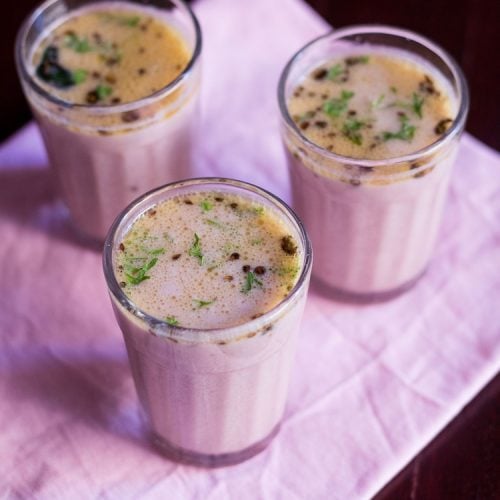
Solkadhi Recipe | Solkadi (Kokum Curry)
Ingredients
For the solkadi
- 12 kokums – dried
- 1 cup water – for soaking
- 2 cups water – to be added later
- 1 to 1.5 cups Coconut Milk (Thick) or half-half of thick coconut milk and thin coconut milk
- 1 to 2 tablespoons chopped coriander leaves – for garnish
- salt as required
For tempering
- 1 to 1.5 tablespoons oil – any neutral oil
- 1 teaspoon mustard seeds
- 1 teaspoon cumin seeds
- 1 sprig curry leaves or 9 to 10 curry leaves
- 1 generous pinch asafoetida
- 2 to 3 small to medium garlic cloves – slightly crushed
- 1 to 2 dry kashmiri red chilies – halved and seeds removed
Instructions
Soaking kokum
- Rinse kokums lightly in water. Place them in a bowl and add 1 cup water.
- Soak the kokums in the water for 30 minutes.
Crushing kokum
- After 30 minutes, crush and squeeze kokum completely with your fingers in the water itself.
- Pour the kokum extract in a strainer. Keep a bowl beneath the strainer.
- The kokum shreds will collect in the strainer.
- Press the kokum shreds with a spoon so that the kokum flavors are extracted well.
Making sol kadhi
- Then add 2 cups water to the kokum extract.
- Next add 1 cup thick coconut milk – either make homemade coconut milk or use the canned or packaged one. You can also add 1.5 cups of coconut milk. Mix very well.
- Add salt as per taste. Mix again well. Keep aside so that we prepare the tempering.
Making tempering
- Heat oil in a tadka pan or a small frying pan. Keep heat to a low.
- Add mustard seeds. Let them crackle.
- Then add cumin seeds and let them crackle too.
- Lastly add the curry leaves, dry red chilies (broken and seeds removed), lightly crushed garlic cloves (with or without peels) and a generous pinch of asafoetida powder. You can crush the garlic cloves in a mortar-pestle and set them aside before you prepare the tempering
- Fry for some seconds stirring often till the garlic turns light golden. Quickly pour this tempering on the kokum and coconut milk mixture. Mix well.
- Then add the finely chopped coriander leaves to sol kadi and mix again.
- Serve sol kadhi straight way or refrigerate for a few hours and then serve cold. You can garnish solkadhi with coriander leaves before serving. Do not keep at room temperature as the coconut milk can turn rancid.Do not keep any leftovers in the fridge for the next day and try to consume the beverage on the same day. Coconut milk get rancid easily even after refrigeration for a day, so try to finish the drink the same day.
Notes
- 1 cup grated coconut and ½ to ¾ cup water.
- Grind the grated coconut with water and squeeze out the thick milk with a strainer.
- Add the extracted coconut again back to the grinder. Add some water and then make the thin milk. Strain again and squeeze the coconut completely.
- You can add both the thick and thin milk to the kokum extract.
- Make the solkadhi less sour: Simply add some more coconut milk to balance the sour taste of kokum.
- Coconut Milk: Remember to use thick coconut milk and not lite or thin coconut milk. For homemade coconut milk, use the first extract or the first blend. Do not use coconut milk made from coconut powder as this will curdle the coconut milk.
- Spice Variations: Instead of dry red chillies, you can add 1 green chilli, chopped or slit. Skip out the asafoetida for a gluten-free drink.
- Scaling: The recipe is easily scalable. Make half portion or double the recipe as needed.
Nutrition Info (Approximate Values)
This solkadhi recipe from the blog archives first published in March 2012 has been republished and updated on 15 January 2022.
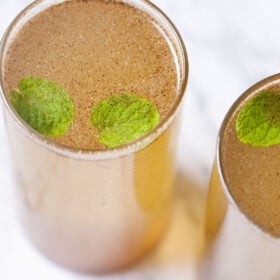


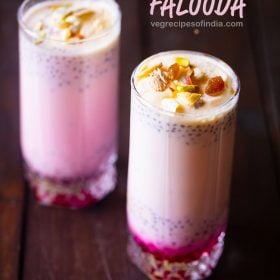
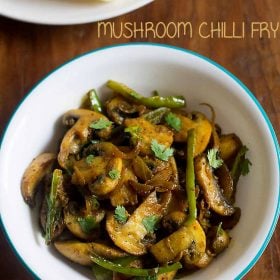











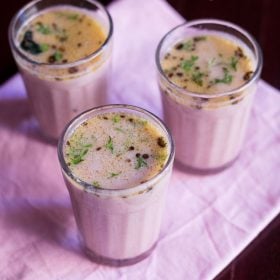
How can i preserve solkadhi for 7 days? Which preservative can be added to it?
I don’t think you can preserve it for 7 days. The coconut milk in it will get rancid in a few days even when refrigerated.
Thanks, Dasna,
I love solkadhi so much , but was not sure about ingredients, since long I was trying but it was not giving that taste, which I longed for, My family is in Toronto , Canada and do travel lot , some times I get tiered of hotel food and try my hand
at gastove, thanks again.
Dr Anil Datey.
thank you Dr Anil. i hope you like the solkadhi recipe when you make it. welcome.
Making it today..! is it possible to get nutrition info ?
Hi! After reading the recipe i bought kokum but did not realise it was a wet kokum. Can i still use it?
of course you can. but just make sure its not sweet.
Hi can I use the maggi coconut milk powder???
maggi coconut milk powder won’t give you a good taste and flavor. i have used coconut milk powder before and it does not even come close to the real taste of kokum curry.